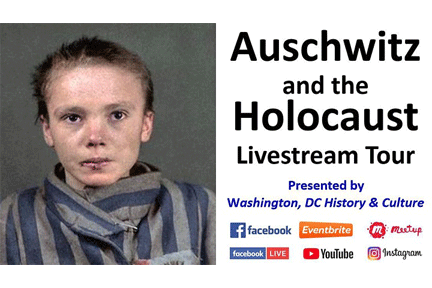Auschwitz Concentration Camp – Livestream History Tour
Event Category: All Events, Learning/Education, and Presentations/Discussions
-
Sunday, June 5, 2022 at 7:00 PM
We welcome you to join us for an online/virtual tour of the Auschwitz concentration camp in Southern Poland.
This program complements our other holocaust history programs:
– Holocaust History Museums Tour: Washington, DC & Richmond, VA
https://www.eventbrite.com/e/holocaust-history-museums-washington-dc-and-richmond-va-livestream-tour-tickets-218960154717
– Anne Frank’s Europe: Before, During & After Her Diary
https://www.eventbrite.com/e/anne-franks-europe-before-during-and-after-her-diary-livestream-tour-tickets-220531314097
Our Auschwitz program will be a slide and video type presentation with historical commentary, not an actual live broadcast from Auschwitz because of Covid. We’ll also include a reading of select passages related to Auschwitz from the excellent book “Our Crime Was Being Jewish: Hundreds of Holocaust Survivors Tell Their Stories” by Anthony Pitch.
At this time the program will not be recorded but will be repeated again on a TBD Sunday in the near future.
Auschwitz concentration camp was a complex of over 40 concentration and extermination camps operated by Nazi Germany in occupied Poland (in a portion annexed into Germany in 1939) during World War II and the Holocaust. It consisted of Auschwitz I, the main camp (Stammlager) in Oświęcim; Auschwitz II-Birkenau, a concentration and extermination camp with gas chambers; Auschwitz III-Monowitz, a labor camp for the chemical conglomerate IG Farben; and dozens of subcamps. The camps became a major site of the Nazis’ Final Solution to the Jewish Question.
After Germany sparked World War II by invading Poland in September 1939, the Schutzstaffel (SS) converted Auschwitz I, an army barracks, into a prisoner-of-war camp.
The initial transport of political detainees to Auschwitz consisted nearly solely of Poles to whom the camp was initially established. The bulk of inmates were Polish for the first two years.
In May 1940, German criminals brought to the camp as functionaries, established the camp’s reputation for sadism. Prisoners were beaten, tortured, and executed for the most trivial reasons. The first gassings—of Soviet and Polish prisoners—took place in block 11 of Auschwitz I around August 1941. Construction of Auschwitz II began the following month, and from 1942 until late 1944 freight trains delivered Jews from all over German-occupied Europe to its gas chambers. Of the 1.3 million people sent to Auschwitz, 1.1 million died. The death toll includes 960,000 Jews (865,000 of whom were gassed on arrival), 74,000 ethnic Poles, 21,000 Roma, 15,000 Soviet prisoners of war, and up to 15,000 other Europeans. Those not gassed died of starvation, exhaustion, disease, individual executions, or beatings. Others were killed during medical experiments.
Only 789 Schutzstaffel personnel (no more than 15 percent) ever stood trial after the Holocaust ended; several were executed, including camp commandant Rudolf Höss.
As the Soviet Red Army approached Auschwitz in January 1945, toward the end of the war, the SS sent most of the camp’s population west on a death march to camps inside Germany and Austria. Soviet troops entered the camp on 27 January 1945, a day commemorated since 2005 as International Holocaust Remembrance Day and the camp became a dominant symbol of the Holocaust.
-
-

